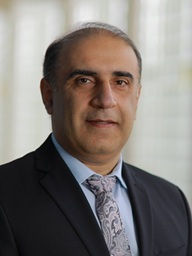Electromagnetic-Plasma Interactions: From Fascinating Physics to Real-World Applications
The University of Michigan Radiation Lab and Trident Chapter are pleased to host Professor Abbas Semnani from the University of Toledo. Prof. Semnani will give a seminar, "Electromagnetic-Plasma Interactions: From Fascinating Physics to Real-World Applications" at 11:30 am ET on Friday, October 24.
This in-person seminar is free and open to the public and will be held in room EECS 1200 on the University of Michigan North Campus in Ann Arbor, MI.
Prof. Semnani will be available after the talk for questions and 1-on-1 meetings. To arrange a meeting, please contact the hosts.
SEM Trident Chapter (AP03/ED15/MTT17/PHO36) website
Co-host: SEM Chapter 15 (NPS05)
Co-sponsor: University of Michigan Radiation Laboratory (website)
Date and Time
Location
Hosts
Registration
-
 Add Event to Calendar
Add Event to Calendar
- 1301 Beal Ave
- University of Michigan North Campus
- Ann Arbor, Michigan
- United States 48109
- Building: EECS Building
- Room Number: 1200 EECS
- Contact Event Hosts
- Co-sponsored by University of Michigan Radiation Laboratory
Speakers
Abbas Semnani of University of Toledo
Electromagnetic-Plasma Interactions: From Fascinating Physics to Real-World Applications
Semiconductor devices, MEMS, liquid crystals, and ferrite materials have long been used as high-frequency tuning elements, but they face fundamental limitations in tuning range, power handling, and miniaturization—critical challenges for next-generation RF systems. Cold plasmas offer a disruptive alternative: by precisely controlling internal plasma parameters such as electron density, their dielectric permittivity and conductivity can be unprecedently tuned, enabling novel, reconfigurable electronic and RF devices with extreme reconfigurability. Beyond RF tuning and radiation, cold plasmas have also emerged as an enabling technology in many other fields, including medical treatments, semiconductor fabrication, electric propulsion, particle acceleration, water decontamination, material processing, and PFAS removal. However, generating stable plasmas is not trivial due to the need for energy-hungry sources. Microwave resonators provide a breakthrough solution by efficiently storing and amplifying electromagnetic energy, enabling energy-efficient plasma generation at power levels as low as milliwatts. These plasmas exhibit superior properties, including higher ionization and dissociation rates, enhanced electron density, and greater production of reactive species while maintaining low temperatures. In this talk, I will review our advances in electromagnetic-plasma interactions, with a focus on high-power microwaves and energy-efficient microwave plasma sources, highlighting key applications.
Biography:
Abbas Semnani is an Associate Professor of Electrical Engineering and the Director of the Adaptive Radiofrequency and Plasma Lab (ARPL) at the University of Toledo. Before joining UToledo in 2019, he spent seven years at Purdue University, where he focused on micro-discharges in high-frequency micro/nanoelectronics. His research interests include high-power microwaves, tunable and compact antennas, reconfigurable RF electronics, and microwave plasma sources for various applications. Dr. Semnani received the 2019 IEEE 'Tatsuo Itoh' Award, the NASA Glenn Faculty Fellowship in 2022, and the NSF CAREER Award in 2024. His research has been supported by NSF, DOE, ONR, ARL, NSWC Crane, Lockheed Martin, and Collins Aerospace.
Email:
Address:Toledo, Ohio, United States, 43606
Agenda
Welcome: 11:30 am
Presentation
Q&A
Closing
Radlab Seminar Series
Electromagnetic-Plasma Interactions: From Fascinating Physics to Real-World Applications
|
|
Prof. Abbas Semnani, Ph.D. Associate Professor, Department of Electrical Engineering and Computer Science
|
Abstract: Semiconductor devices, MEMS, liquid crystals, and ferrite materials have long been used as high-frequency tuning elements, but they face fundamental limitations in tuning range, power handling, and miniaturization—critical challenges for next-generation RF systems. Cold plasmas offer a disruptive alternative: by precisely controlling internal plasma parameters such as electron density, their dielectric permittivity and conductivity can be unprecedently tuned, enabling novel, reconfigurable electronic and RF devices with extreme reconfigurability. Beyond RF tuning and radiation, cold plasmas have also emerged as an enabling technology in many other fields, including medical treatments, semiconductor fabrication, electric propulsion, particle acceleration, water decontamination, material processing, and PFAS removal. However, generating stable plasmas is not trivial due to the need for energy-hungry sources. Microwave resonators provide a breakthrough solution by efficiently storing and amplifying electromagnetic energy, enabling energy-efficient plasma generation at power levels as low as milliwatts. These plasmas exhibit superior properties, including higher ionization and dissociation rates, enhanced electron density, and greater production of reactive species while maintaining low temperatures. In this talk, I will review our advances in electromagnetic-plasma interactions, with a focus on high-power microwaves and energy-efficient microwave plasma sources, highlighting key applications.
Bio: Abbas Semnani is an Associate Professor of Electrical Engineering and the Director of the Adaptive Radiofrequency and Plasma Lab (ARPL) at the University of Toledo. Before joining UToledo in 2019, he spent seven years at Purdue University, where he focused on micro-discharges in high-frequency micro/nanoelectronics. His research interests include high-power microwaves, tunable and compact antennas, reconfigurable RF electronics, and microwave plasma sources for various applications. Dr. Semnani received the 2019 IEEE 'Tatsuo Itoh' Award, the NASA Glenn Faculty Fellowship in 2022, and the NSF CAREER Award in 2024. His research has been supported by NSF, DOE, ONR, ARL, NSWC Crane, Lockheed Martin, and Collins Aerospace.


